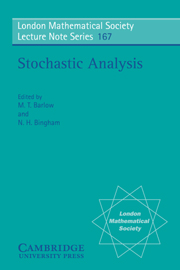Book contents
- Frontmatter
- Contents
- Preface
- List of participants
- An evolution equation for the intersection local times of superprocesses
- The Continuum random tree II: an overview
- Harmonic morphisms and the resurrection of Markov processes
- Statistics of local time and excursions for the Ornstein–Uhlenbeck process
- LP-Chen forms on loop spaces
- Convex geometry and nonconfluent Γ-martingales I: tightness and strict convexity
- Some caricatures of multiple contact diffusion-limited aggregation and the η-model
- Limits on random measures and stochastic difference equations related to mixing array of random variables
- Characterizing the weak convergence of stochastic integrals
- Stochastic differential equations involving positive noise
- Feeling the shape of a manifold with Brownian motion — the last word in 1990
- Decomposition of Dirichlet processes on Hilbert space
- A supersymmetric Feynman-Kac formula
- On long excursions of Brownian motion among Poissonian obstacles
Feeling the shape of a manifold with Brownian motion — the last word in 1990
Published online by Cambridge University Press: 31 March 2010
- Frontmatter
- Contents
- Preface
- List of participants
- An evolution equation for the intersection local times of superprocesses
- The Continuum random tree II: an overview
- Harmonic morphisms and the resurrection of Markov processes
- Statistics of local time and excursions for the Ornstein–Uhlenbeck process
- LP-Chen forms on loop spaces
- Convex geometry and nonconfluent Γ-martingales I: tightness and strict convexity
- Some caricatures of multiple contact diffusion-limited aggregation and the η-model
- Limits on random measures and stochastic difference equations related to mixing array of random variables
- Characterizing the weak convergence of stochastic integrals
- Stochastic differential equations involving positive noise
- Feeling the shape of a manifold with Brownian motion — the last word in 1990
- Decomposition of Dirichlet processes on Hilbert space
- A supersymmetric Feynman-Kac formula
- On long excursions of Brownian motion among Poissonian obstacles
Summary
Introduction.
In 1984 [P1] we introduced the theme of inverse problems for Brownian motion on Riemannian manifolds, in terms of the mean exit time from small geodesic balls. Since that time a number of works have appeared on related stochastic problems as well as on some classical, non-stochastic quantities which may be treated by the same methods. Most recently H.R. Hughes [Hu] has shown that in six dimensions one cannot recover the Riemannian metric from the exit time distribution, thereby answering in a strong sense the main question posed in [P1].
The general area of “inverse spectral theory” was initiated by Mark Kac in his now famous paper [Ka] on the two-dimensional drumhead. In the intervening years a large literature has developed on inverse spectral problems in higher dimensional Euclidean space and differentiable manifolds; for recent surveys see ([Be], [Br], [Go]). In these approaches one is given the entire spectrum of eigenvalues, from which one asks various geometric questions. Our approach, by contrast, is able to obtain strong geometric information from the sole knowledge of the principal eigenvalue of a parametric family of geodesic balls (see section 6, below).
- Type
- Chapter
- Information
- Stochastic AnalysisProceedings of the Durham Symposium on Stochastic Analysis, 1990, pp. 305 - 320Publisher: Cambridge University PressPrint publication year: 1991
- 2
- Cited by



